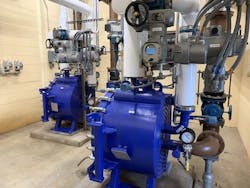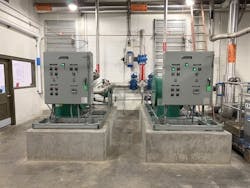Enhanced Biosolids Reuse & Reduction Project
Cost: $12,740,000
Location: Mount Crawford, Virginia
Year: 2020-12-31
Size: 4,100 lb/hr (evaporative capacity)
22 mgd (permited design capacity)
Owner: Harrisonburg-Rockingham RSA
Designers: Rummel, Klepper & Kahl
Buchart Horn
Contractor: MEB General Contractors
The Harrisonburg-Rockingham Regional Sewer Authority (HRRSA) owns and operates the North River Wastewater Treatment Facility (NRWWTF), which is located in Mount Crawford, Virginia. NRWWTF is a 22 million gallons per day (mgd) regional municipal wastewater treatment facility that achieved enhanced nutrient removal (ENR) treatment standards. The facility usually treats between 13 and 14 mgd.
“The project was ultimately funded through the Clean Water Revolving Fund, [and] was financed for $12.74 million, but there was a lot of working between to make the project pay for itself,” said Sharon Foley, executive director of HRRSA.
The EBRR Project sought to recover the excess anaerobic digester gas beyond that used for digester heating to fuel a biosolids dryer and provide additional dewatering of Class B biosolids.
The treatment facility’s dewatered Class B biosolids have a solids content of approximately 18% solids at an annual production rate of 16,000 wet tons per year. After thermal drying, the final product has greater than 90% solids and meets the U.S. EPA definition of Class A Exceptional Quality (EQ) biosolids. The annual production rate was reduced to approximately 3,000 wet tons per year.
The project is strategically important since the Class A EQ material has superior pathogen reduction and significantly increases biosolids storage and disposal options. There are currently no regulatory drivers for producing Class A biosolids in Virginia, so the EBRR Project had to be self-funded by the cost savings. These cost savings were achieved by reducing the volume of biosolids being hauled and from the additional revenue received from co-digestion of imported poultry processing waste.
The project began in January 2018 and concluded in October 2019. Since completion, the biosolids dryer system has proven to be completely sustainable on the biogas produced by anaerobic co-digestion, and the dryerʼs waste heat recovery system at the NRWWTFʼs current biosolids production rate. This is all while achieving greater than 90% solids and non-detectable levels of pathogenic organisms, according to facility management.
The team set clear goals to achieve success and organization throughout the project. Working with NRWWTF and engineer meant minutely detailing each part of the project to ensure total confidence.
Two critical challenges included increasing digester biogas production through increased co-digestion of local poultry processing sludge so that the biosolids could be dried without supplemental fossil fuel; and utilizing spiral heat exchangers for waste heat recovery of the biogas dryer system to generate additional energy to heat the anaerobic digester system so that most of the biogas could be used for biosolids drying.
Part of the design of the dryer system included recovering the waste heat from the dryer. It was critical to have enough energy to both heat the digester and to provide enough biogas for the dryer.
During commissioning time, the team used no propane once it acquired biogas, since propane is expensive. In the year it started operating, the team had not used any propane since originally filling that tank.


